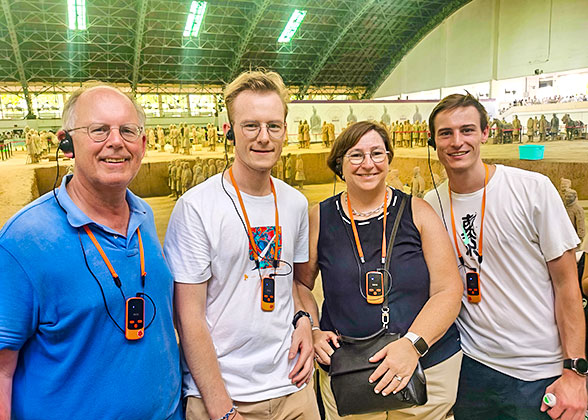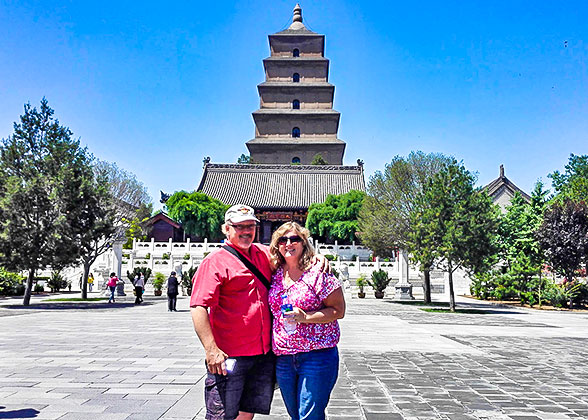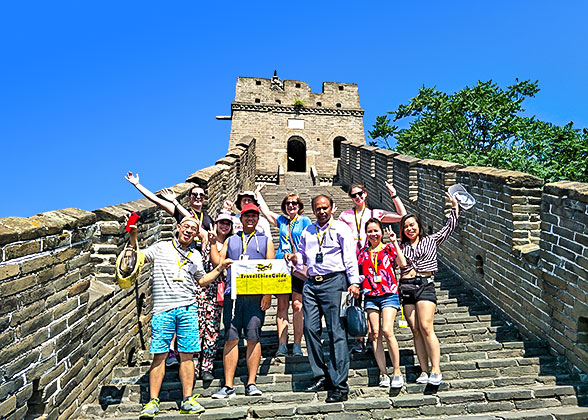Many people have noted that none of the famous terracotta warriors are depicted wearing helmets. Some high-ranking officers wear leather caps, but the majority have their hair tied in a bun with no head protection at all. This accurately reflects the real practice of Qin soldiers during the Warring States Period (475 - 221BC) and the subsequent
Qin Dynasty (221 -207 BC); they typically went into battle bareheaded, without helmets.
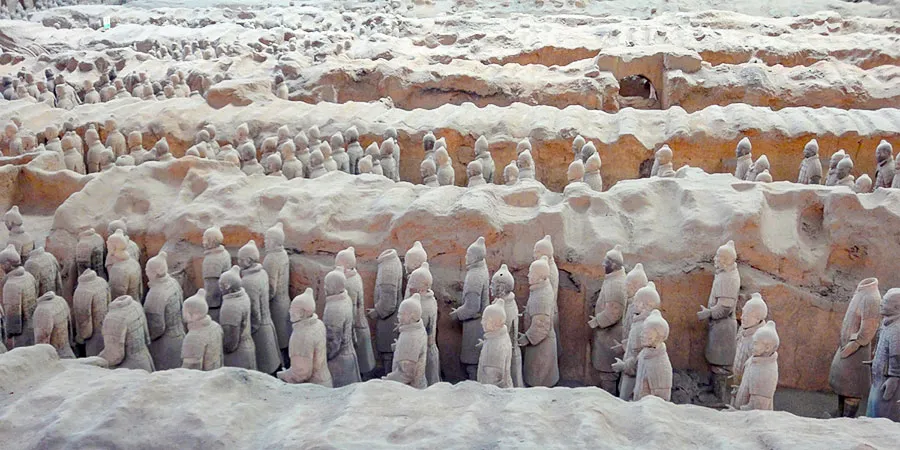 |
| Terracotta Warriors Wearing No Helmet |
So, why didn't such a powerful Qin army wear helmets?
1. They believed that not wearing helmets represented bravery.
The Qin people held martial valor in high esteem, and going into battle without a helmet was considered a mark of exceptional courage and fearlessness. Historical records indicate that Qin soldiers often shed their armor during combat to display their fearless spirit. This cultural atmosphere fostered a sense of pride among soldiers in being lightly equipped on the battlefield, intimidating the enemy with their imposing momentum. Scholars have pointed out that this deep-seated tradition of celebrating martial prowess motivated Qin soldiers to fight fiercely on the battlefield, and not wearing helmets became a distinctive characteristic that differentiated them from the armies of other states.2. Heavy helmets could impair soldiers' mobility.
The military merit award system implemented by the Qin Dynasty directly tied a soldier's personal advancement and rewards to his performance on the battlefield. Specifically, soldiers could obtain grant noble ranks and material benefits such as lands, houses, and servants based on the number of enemies they killed. Driven by the desire to earn these honors and kill the enemy more quickly, soldiers often voluntarily chose to forgo helmets, which they perceived as potentially hindering their movements.
Their helmets, especially those made of bronze weighing over 1.5 kilograms (3.3 pounds), could restrict head mobility, narrow the field of vision, and even become a burden in close combat. By fighting lightly equipped, soldiers could dodge and strike more freely, thereby increasing their chances of survival and victory.
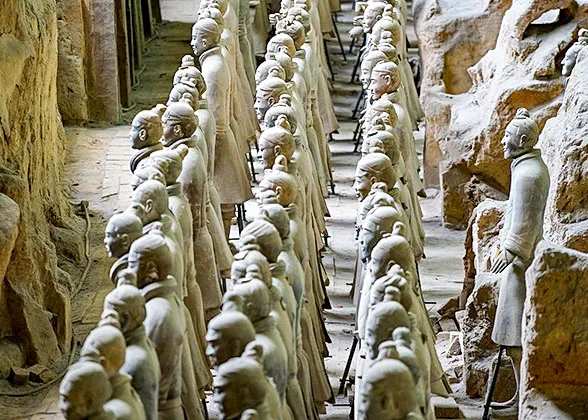 | | Infantry Warriors without Helmets in Pit 1 | | 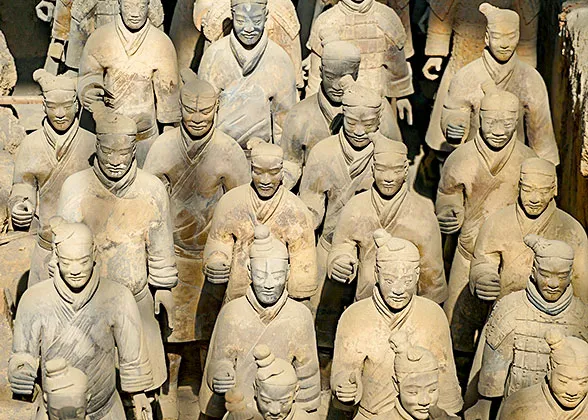 | | Helmetless Terracotta Warriors | |
3. The production cost of helmets was too high.
Helmets at that time were mostly cast from bronze or iron, making them expensive and of little practical use beyond warfare. Moreover, the primary weapons used in that period, such as halberds and swords, were designed mainly for thrusting attacks aimed at the chest and abdomen, making head injuries relatively less common. As a result, helmets were probably not viewed as essential gear. Therefore, when considering cost-effectiveness, more funds were allocated to weapons and body armor instead of helmets.
4. Helmets were removed to show respect for the emperor.
The
Terracotta Army, constructed as a part of Emperor Qin Shi Huang's burial complex, is believed to represent the imperial guard during ceremonial inspections, occasions where helmets were removed as a sign of deference. Historical texts record that when the Qin troops passed through the northern gate of the Zhou capital, they took off their helmets and dismounted to show respect to the Zhou emperor. Thus, experts infer that the terracotta warriors are depicted without helmets to recreate the formal atmosphere during imperial reviews.
Stone Helmets - Used as Burial Objects
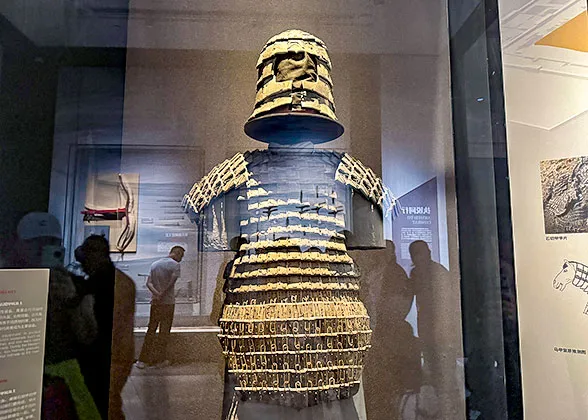 |
| Stone Helmet and Armor |
When visiting the Terracotta Army, you may see stone helmets displayed in the exhibition cases. Unearthed from
Pit K9801, an accessory burial pit of the
Emperor Qin Shi Huang's Mausoleum, these stone helmets were not intended for actual combat but served as burial objects. Their manufacturing process was relatively complex, making large-scale production impractical. Additionally, they were excessively heavy and unsuitable for prolonged wear in battle. Moreover, the stone material lacked the necessary toughness, further indicating that these helmets were not designed for practical warfare. However, the discovery of these stone helmets demonstrates that the Qin people possessed the technology to produce helmets.

Further Reading:
 Terracotta Warriors Pit 1
Terracotta Warriors Pit 1 Terracotta Warriors Pit 2
Terracotta Warriors Pit 2 Terracotta Warriors Pit 3
Terracotta Warriors Pit 3 Exhibition of Archaeological Discoveries
Exhibition of Archaeological Discoveries Emperor Qin Shi Huang's Mausoleum Site Museum
Emperor Qin Shi Huang's Mausoleum Site Museum Emperor Qin Shi Huang - First Emperor of China
Emperor Qin Shi Huang - First Emperor of China Hairstyle and Headgear of Terracotta Warriors
Hairstyle and Headgear of Terracotta Warriors What Are the Terracotta Warriors Wearing?
What Are the Terracotta Warriors Wearing? Secret Revealed from the Ears of Terracotta Warriors
Secret Revealed from the Ears of Terracotta Warriors Let's Smash the 5 Rumors of the Terracotta Army
Let's Smash the 5 Rumors of the Terracotta Army 8 Cool Facts You May Not Know about the Terracotta Army
8 Cool Facts You May Not Know about the Terracotta Army How to Visit Terracotta Army - A Perfect One-Day Tour Plan?
How to Visit Terracotta Army - A Perfect One-Day Tour Plan?- Last updated on Nov. 17, 2025 by Doris Xue -




